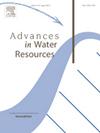Water vapor condensation in porous media: Effects of fracture, porosity, and flow rate revealed by rapid 4D neutron imaging
IF 4
2区 环境科学与生态学
Q1 WATER RESOURCES
引用次数: 0
Abstract
This study investigates water vapor condensation processes in a fractured porous medium (sandstone), focusing on the effects of fracture conductivity, matrix porosity, and imposed flow rate of the vapor. Cylindrical samples of Fontainebleau sandstone were pre-fractured using the Brazilian splitting test and subjected to a constant vapor and air mixture flow rate. Rapid in situ neutron tomography, captured every 30 s, visualized time-resolved water migration through the porous media. Owing to the high neutron attenuation by hydrogen, the obtained contrast allowed quantitative 3D tracking of condensed water within the material bulk. The experimental data demonstrated the reliability of neutron imaging through consistent measurements of overall water content, as verified by imposed macroscopic boundary conditions. The results showed that cracks act as preferential pathways for vapor migration, leading to the formation of initial wetting fronts and subsequent capillary absorption into the matrix from inner fracture surfaces. The presence of a crack slowed the propagation of the water front in the porous matrix, allowing more water to accumulate within it. Low porosity samples exhibited lower water contents in the matrix, resulting in faster propagation of the water front due to the limited water absorption capacity of the matrix. In this case, water accumulates in the crack in the form of water patches, especially at lower flow rates, where the vapor’s exerted pressure is lower, allowing more water to remain in the porous matrix. At higher flow rates, cracks remained drier compared to the matrix due to increased injection pressure, which transferred water into the matrix more effectively. Rapid transitions of water patches were observed in the high flow rate low porosity case, highlighting dynamic water movement in the crack. The study underscores the importance of heterogeneity in the form of cracks in the absorption of condensed water and highlights the roles of capillary effects and pressure-driven flow in the transportation of water within fractured porous media. It provides novel full-field experimental datasets, which are invaluable for further numerical simulations.

多孔介质中的水蒸气凝结:裂缝、孔隙度和流量对快速4D中子成像的影响
本研究研究了裂缝性多孔介质(砂岩)中的水蒸气凝结过程,重点研究了裂缝导电性、基质孔隙度和蒸汽施加流速的影响。采用巴西劈裂试验对枫丹白露砂岩柱状试样进行了预压裂,并对其进行了恒定的蒸汽和空气混合流速试验。每30秒捕获一次的快速原位中子层析成像显示了通过多孔介质的时间分辨水迁移。由于氢对中子的高衰减,所获得的对比可以对材料体内的冷凝水进行定量的三维跟踪。实验数据通过对总体含水量的一致测量证明了中子成像的可靠性,并通过施加宏观边界条件进行了验证。结果表明,裂纹是蒸汽运移的优先通道,导致初始润湿锋的形成和随后的毛细管从断裂内表面吸收到基体中。裂缝的存在减缓了水前缘在多孔基质中的扩展,允许更多的水在其中积聚。低孔隙率样品的基质含水量较低,由于基质吸水能力有限,导致水锋扩展更快。在这种情况下,水以水斑的形式积聚在裂缝中,特别是在低流速下,蒸汽施加的压力较低,允许更多的水留在多孔基质中。在高流速下,由于注入压力的增加,裂缝比基质更干燥,从而更有效地将水转移到基质中。在高流量低孔隙度的情况下,观察到水斑的快速转变,突出了裂缝中的动态水运动。该研究强调了裂缝形式的非均质性在凝结水吸收中的重要性,并强调了毛细效应和压力驱动流动在裂隙多孔介质中水运移中的作用。它提供了新颖的全场实验数据集,这对进一步的数值模拟是无价的。
本文章由计算机程序翻译,如有差异,请以英文原文为准。
求助全文
约1分钟内获得全文
求助全文
来源期刊

Advances in Water Resources
环境科学-水资源
CiteScore
9.40
自引率
6.40%
发文量
171
审稿时长
36 days
期刊介绍:
Advances in Water Resources provides a forum for the presentation of fundamental scientific advances in the understanding of water resources systems. The scope of Advances in Water Resources includes any combination of theoretical, computational, and experimental approaches used to advance fundamental understanding of surface or subsurface water resources systems or the interaction of these systems with the atmosphere, geosphere, biosphere, and human societies. Manuscripts involving case studies that do not attempt to reach broader conclusions, research on engineering design, applied hydraulics, or water quality and treatment, as well as applications of existing knowledge that do not advance fundamental understanding of hydrological processes, are not appropriate for Advances in Water Resources.
Examples of appropriate topical areas that will be considered include the following:
• Surface and subsurface hydrology
• Hydrometeorology
• Environmental fluid dynamics
• Ecohydrology and ecohydrodynamics
• Multiphase transport phenomena in porous media
• Fluid flow and species transport and reaction processes
 求助内容:
求助内容: 应助结果提醒方式:
应助结果提醒方式:


